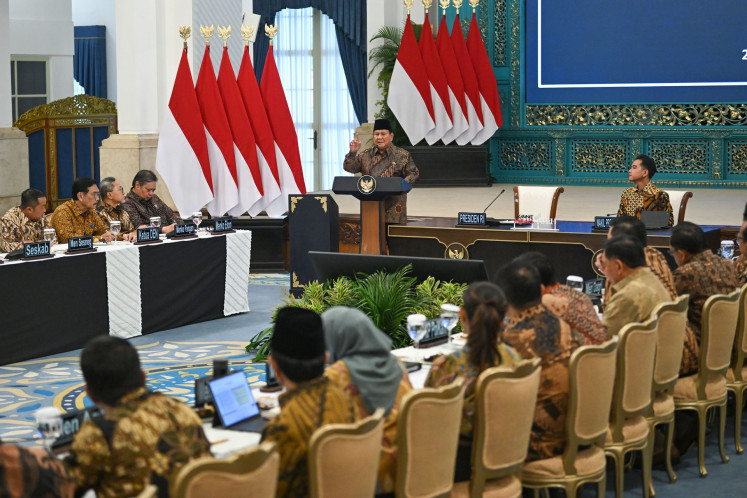Popular Reads
Top Results
Can't find what you're looking for?
View all search resultsPopular Reads
Top Results
Can't find what you're looking for?
View all search resultsDrought aid: Helping hand or harmful handout?
As drought has pushed many local farmers to the edge of an already difficult existence in many parts of Java, Sumatra and Bali, calls for greater governmental assistance in the agricultural sector have multiplied in number and in volume, and for good reason
Change text size
Gift Premium Articles
to Anyone
A
s drought has pushed many local farmers to the edge of an already difficult existence in many parts of Java, Sumatra and Bali, calls for greater governmental assistance in the agricultural sector have multiplied in number and in volume, and for good reason.
According to a recent World Bank report, some 40 percent of Indonesia’s 240 million citizens are employed in the agricultural sector.
However, according to the same report, those involved in producing the nation’s food account for a disproportionate 60 percent of those living in poverty.
Kemal Stamboel, head of the Prosperous Justice Party (PKS) faction in the House of Representatives, suggested the government take pro-active, affirmative steps to boost agricultural production.
“The government has to be fully supportive not only of improving household welfare, but also of developing basic infrastructure, land allocation and asset distribution. If the government doesn’t side with the poorest of society, who mostly depend on agriculture, tackling poverty is a goal that will remain out of reach,” he said.
The government, both at the national and local level, should improve coordination on a range of issues from agricultural infrastructure development — including access to irrigation as well as the roads, railways, and ferry services farmers need to bring their commodities to market — to natural resource management to ensure the long-term stewardship of the land on which farmers rely.
However, the burden of ensuring the prosperity of the nation’s farmers does not lie on the shoulders of civil servants alone, and too large a government presence in the sector, just like any industrial sector, can lead to gross inefficiencies, graft and waste.
The establishment of cooperative corporations, commonly known as co-ops, was a critical development in the history of agriculture in the US. In the 1800s, as America’s population expanded westward, individual farmers were held hostage to private businesses in terms of purchasing supplies (seed, fertilizer and tools), selling their commodities and the transport of those goods in both directions.
Taking advantage of collective bargaining power, farmers united under co-ops to purchase their supplies in bulk and access deep discounts in doing so. Suppliers were no longer free to extort individual farmers and ranchers, but were instead forced to negotiate against the purchasing power of hundreds of potential customers.
Likewise, some co-ops operated beyond pure purchasing units and harnessed the full weight of their economy of scale to sell commodities at better prices than were available to individuals.
Many co-ops further established retail operations and distributed the profits as dividends or reinvested them in productive assets such as wells or granaries.
Because these cooperatives were organized as independent, voluntary organizations, they allowed individual farmers to weigh the benefits of association against remaining independent.
This simple model allows farmers to this day access to supplies and markets on terms that they are able dictate due to their collective position, without an overreliance on government intervention and assistance.
As such, co-ops provide a degree of insulation from the absence or the poor implementation of government programs.
To an extent, this model is already in place in Indonesia, and provides an avenue for the empowerment of Indonesian farmers. This model could certainly be expanded and supported by the adjustment of tax policy and other fiscal incentives.
However, in order to ensure their independence, governmental support of such co-ops must be implemented at an arm’s length and work to support systemic change in the agribusiness environment rather than providing direct cash assistance.
Another crucial development in agricultural advancement in the US was the advent of a variety of agricultural insurance products, commonly known as “crop insurance”.
Crop-yield insurance is available to provide financial protection against torrential rains, drought, insect infestation and bacterial or fungal infections, while crop-revenue insurance protects against drops in the price of a commodity based on average yields and commodity prices on the futures markets.
Both of these products, in addition to the expansion of storage capacity, have been crucial in providing the type of long-term stability and security that has allowed farmers to make decisions on whether to save their proceeds for a potential downturn or whether to invest further in productive capital.
Because most farmers would otherwise be unable to afford the premiums for such insurance, and the financial risk a calamitous event poses to the policy’s underwriter, government insurance firms often step in not only to guarantee the policy but also to bring down the cost of premiums for low-income farmers.
Obviously, the development of a new product like crop insurance would require highly skilled staff such as crop consultants, claims adjusters and actuaries to support its operation and oversight. Rather than being seen as an obstacle, this new demand should be viewed as a positive opportunity to employ some of Indonesia’s top university graduates.
The strengthening of co-ops and the creation of a government-backed crop insurance program would be steps in the right direction, and would encourage levels of investment and strategic planning beyond what can be achieved with the current cash disbursement programs.
However, these steps offer the type of long-term benefits that are of little relief to farmers currently struggling with drought, nor are they designed to.
Local and national government agencies must have the continued flexibility to respond to states of emergency, from more immediate disasters such as floods or volcanic eruptions to prolonged conditions like drought.
Yet, within this flexibility, funds should be disbursed to help create long-term improvements in the land and its management.
State-supported programs in drought-stricken parts of the US have borne the majority of the cost to dig new wells or deepen existing wells in a two-pronged strategy that not only provides immediate relief, but also more lasting benefits.
While cash disbursements may offer temporary comfort, they fall short of addressing the systemic weaknesses of the Indonesian agriculture sector, and in effect are tantamount to putting a Band-Aid on
a bullet wound.
All of the potential reforms and policy initiatives outlined above represent ways to support and strengthen the efforts of those working in the agricultural sector as well as achieving self-sustainability and food
security for the nation.
However, until these initiatives and others like them are put into action, the farmers of today will be left with few options other than looking to the skies and hoping for rain.
The writer is a political observer and consultant in Jakarta. He was raised on a small farm and ranch in western Nebraska, US, before moving to Indonesia.










